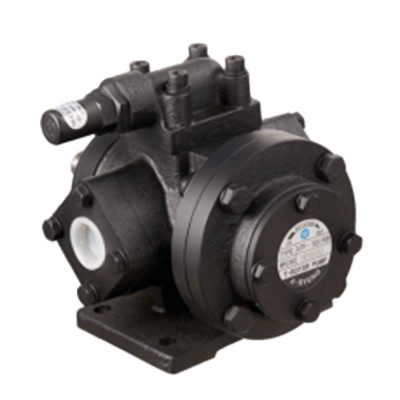What Is a Trochoid Pump?

A trochoid pump is an internally inscribed positive displacement pump that transports fluid by meshing an external gear with an internal gear. It is a registered trademark of Japan Oil Pump Co.
It is called a trochoid pump because the tooth profile of the external and internal gears is shaped like a trochoid curve. A trochoid curve is a curve drawn by a fixed point inside or outside a circle when the circle is rolled without sliding along a certain curve.
When an internal gear is driven, the meshing external gear also rotates in the same direction. This makes them compact, and they have features such as low-gear sliding speed, low noise, and low-pressure pulsation. Although trochoidal pumps are most commonly used for pumping oil, they can also be used for coolants, fuels, and special liquids.
Uses of Trochoid Pumps
Trochoid pumps are mainly used to supply lubricating oil in construction and industrial equipment, machine tools, food machinery, printing machinery, environmental facilities, leisure facilities, and ships. Liquids to be transported include hydraulic systems, abrasive oils, fuels, coolants, and chemicals, other than volatile oils and gasoline.
When selecting trochoid pumps, the operating pressure, speed, discharge rate, temperature, and type of liquid being conveyed should be considered.
Principle of Trochoid Pumps
Trochoid pumps consist of a circular casing with two gears whose tooth profile is a trochoid curve, a shaft, a bearing, a suction port, a discharge port, a shaft seal, a relief valve, and a suction strainer.
There are two types of gear, one that fits into the inner circular casing and the other that fits inside the outer gear. The number of teeth in the inner gear is one less than in the outer gear, and both gears are eccentric. A shaft is connected to the center of the inner gear to rotate it.
When the inner gear rotates, the outer gear, which is meshed with the inner gear, also rotates, but the outer gear rotates slower than the speed of the inner gear. The volume of the space separated by the two gears then changes. This change in volume causes the fluid to be sucked in at the suction port and discharged at the discharge port, thus functioning as a pump.
Trochoid pumps are pumps with a constant discharge rate. When the rotation speed is constant, the relationship between the discharge volume and pressure is inversely proportional, and the discharge volume is maximum when the pressure is zero. When the pressure is at maximum, the discharge volume is zero, but the drive power is at maximum, which may cause the electric motor to overload.
Other Information About Trochoid Pumps
1. Characteristics of Trochoid Pumps
Trochoid pumps have four characteristics:
- Compactness
Because it is an internally geared pump, it is smaller than other pumps of the same capacity. Therefore, it allows for greater freedom in equipment design. - Self-priming
Because it is a positive displacement pump and self-priming, unlike other centrifugal pumps, it has the advantage of not requiring priming oil. - Low Noise and Low Pressure Pulsation
The internal gears have low sliding velocity, resulting in low meshing noise and low-pressure pulsation. - Low Cost
The simple structure allows the inner and outer gears to be manufactured with sintered alloys, making them relatively inexpensive.
2. Failure of Trochoid Pumps
Clogging of the suction piping or strainer can cause problems such as failure to raise the discharge pressure. The filter on the suction side should be inspected and cleaned. There is also a possibility that air cannot be suctioned and discharged due to pinholes in the line or improper tightening at the flange.
Furthermore, when the machine is restarted after a long shutdown, the viscosity of the liquid may have increased or it may be sticking. Failures that cause liquid leakage are most likely due to deterioration or damage to the sealing parts. It is important to perform preventive maintenance by deciding on a maintenance cycle, such as periodically replacing oil seals and other consumable parts.
There is also a possibility of one-sided tightening for leakage at the flange surface. When cavitation occurs in the pump, abnormal noise is generated. If cavitation is occurring, the suction pressure of the pump should be measured and the loss or resistance on the suction piping side should be lowered as much as possible.
If the liquid is near the saturation vapor pressure of the liquid due to outside temperature, it may flush. If the bearing part is damaged, the bearing must be replaced. It is important to perform maintenance to replace them periodically as consumable parts.